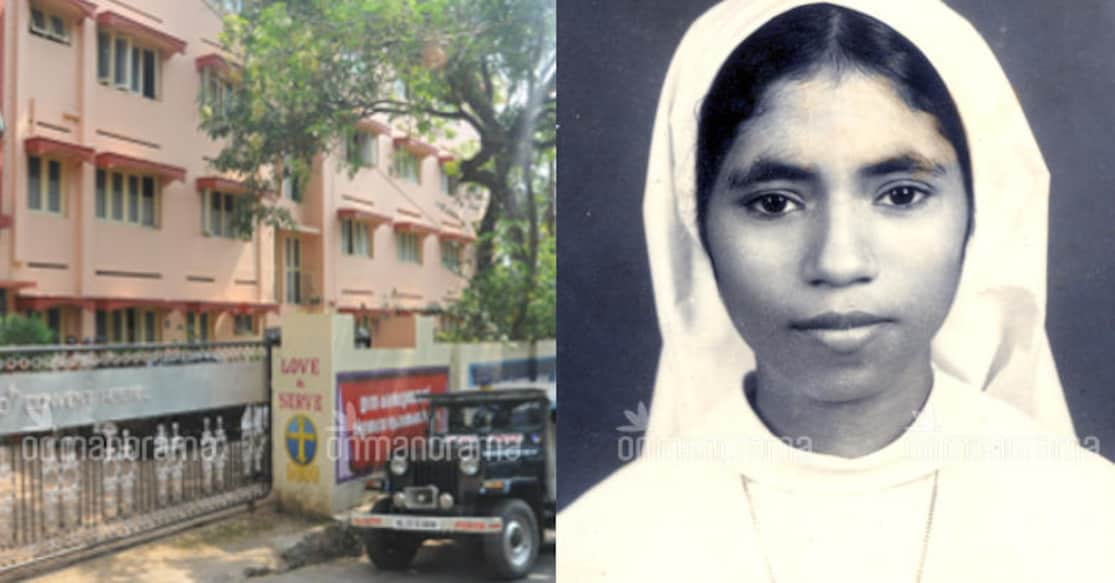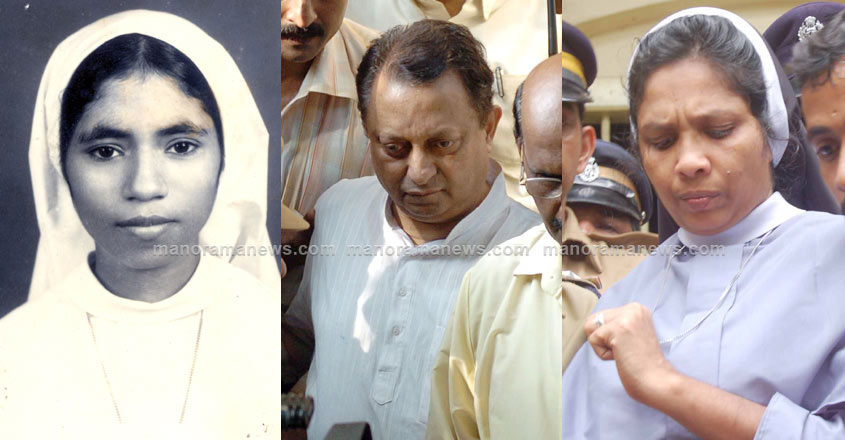Vampire marks on Sr Abhaya's neck and mystery of missing photographs

The body of Sister Abhaya, a 19-year-old nun residing at the Pius X convent in Kottayam, was found in a well on the morning of March 27, 1992.
The body of Sister Abhaya, a 19-year-old nun residing at the Pius X convent in Kottayam, was found in a well on the morning of March 27, 1992.
The body of Sister Abhaya, a 19-year-old nun residing at the Pius X convent in Kottayam, was found in a well on the morning of March 27, 1992.
It was a mixed bag for the prosecution on Tuesday in the Sister Abhaya murder trial that is underway in the CBI Special Court in Thiruvananthapuram.
During the forenoon session, lawyers led by B Raman Pillai were able to poke holes in the testimony of Kalarkode Venugopalan Nair, who had on Monday said that Fr Thomas Kottoor had confessed to him about a sinful relationship with Sister Sephy. However, in the post-lunch session photographer Varghese Chacko, the man who had taken the pictures of Abhaya's dead body for inquest, stood his ground in the face of some shrewd questioning.
Varghese said he was asked by the owner of Venus Studio – the firm where he worked – to go to Pius X Convent on the morning of March 27, 1992, to take the pictures of a nun, who was found dead in the convent.
At the Convent, he saw the dead body of Abhaya covered in a white shroud.
"The white sheet was only up to the neck. I could see her face," Varghese told the CBI Court on Tuesday.
Bloody marks on the neck

He said nail marks were visible on either side of Sr Abhaya's neck. On the orders of the police, he took the pictures of the dead body, and also certain areas of the Convent premises like the well from which Abhaya's body was fished out.
Varghese said he had taken ten pictures using his Minolta camera with a 25/70 lens.
He developed the pictures and handed them over to his owner. When a policeman came asking for the pictures, he said the Studio sought the opinion of a senior Crime Branch official before handing the ten pictures and the negatives to the policeman. A bill of Rs 200 was then sent to the Convent.
Missing photographs and truth test
Varghese told the court that the nail marks were clearly visible on the photographs. The prosecution then produced a set of sepia-toned photographs and handed it over to Varghese. After taking a look, Varghese said there were only six photographs. "Four photographs, and their negatives, are missing," he said. The four included three close-ups of Sr Abhaya's face – one each from either side of the face and a straight one – and a shot from the feet of the dead nun.
Defence lawyer Raman Pillai sought to confuse Varghese. "Were you taken to Bangalore for some tests," he asked. Varghese said yes.
The photographer had undergone both polygraph and brain mapping tests. "The polygraph results show that you have not said anything about the nail marks," Pillai said.
Varghese was quick to spot the trap. "I said so only when they asked whether there were any injury marks at the back side of Abhaya's body," he said. Varghese said he had not taken a photograph of Abhaya's dead body turned on its back.
Long shot trap
Pillai asked Varghese to once again have a look at the photographs he had taken. There were two pictures of Abhaya's body in the set of six. "Can you see any nail marks," he asked.
"I can't because they are long shots. The nail marks are visible only in the close-up pictures that are now lost," he said. Prosecution lawyer Nawaz then said that the main contention of the CBI was that crucial evidence had been destroyed.
Another defence lawyer J Jose then asked Varghese whether he had seen blood in any other part of Abhaya's body. He said no. Perhaps in an attempt to throw Varghese off balance and show him up as a liar, Jose asked Varghese to describe the face of the dead nun. "Were the eyes and mouth open," he asked. Varghese first said he could not recall how the body looked on the day. He then thought a bit hard and said he did not notice these things on his photographs. "Had it been so it should have shown in the pictures. It did not," he said.
Jose then told him that he was lying about ten photographs. "I had told the police about it. Moreover, the Bill for the ten photographs is with the Convent," Varghese replied. Varghese's cross did not last for more than 45 minutes.
Witness corrects himself
However, Kalarkode Venugopalan Nair's cross examination extended for nearly four hours. Kalarkode began the day by contradicting his own testimony the previous day. On Monday he had said that he had met Fr Kottoor at the Bishop's House before the narco analysis was done on him. Today he corrected himself saying that he had met Kottoor after the narco test was carried out.
"Was it Jomon Puthenpurakkal (the litigant in the Sr Abhaya murder case) who coached you to change your statement," Raman Pillai asked in jest. The defence, however, was more interested in unveiling bigger contradictions in Kalarkode's testimonies to various investigating agencies and courts.
Corrupt litigant
But before Pillai began dismantling Kalarkode's testimony, he sought to paint the witness as corrupt, as a habitual litigant with a history of profiting from filing cases against Christian priests.
Pillai said Kalarkode had first filed a case against Muringoor Divine Retreat Centre and then withdrew it when it came to the Supreme Court.
Kalarkode said it was not a withdrawal. "My contention was that many were found dead in the Centre and no probe had yet taken place. The Supreme Court summoned me and asked me why I was so adamant on having this issue re-examined. If the highest court of the land was not keen who am I to insist," Kalarkode said.
Pillai also attempted to insinuate that Kalarkode was corrupt. That he was once the peon and driver of PSC chairman Gopalakrishna Kurup came seems to have prompted the defence lawyer's charge. "Is it true that you have sought money from job aspirants," Pillai asked. Kalarkode categorically denied it.
Priest hater or true Hindu
The difference in the qualifications of the accused (Fr Kottoor) and the witness was also sought to be made. First, the court was told that Kalarkode had not even passed his SSLC. And then Fr Kottoor's standing was revealed. "Do you know that Fr Kottoor was the chancellor of the Kottayam diocese," Pillai asked. Kalarkode said he knew. He also knew that Fr Kottoor was psychology professor at DCM College, Kottayam.
"He also has a doctorate in theology from a foreign university, and a post graduation and M.Phil in psychology," Pillai said. Kalarkode was not aware. "He has also authored six books," Pillai said. At this point, even the magistrate found it a bit too much. Pillai smiled, and relented.
Kalarkode, too, had his rhetorical moment. When he was told that he despised Christian priests, the witness said: "I have no ill feeling towards any priests. I am a Hindu. I cannot despise anyone."
Double speak
Raman Pillai then started questioning him about the discrepancy in his testimonies. Many of the witness's statements, like Kottoor's confession of a sinful bond with Sephy, it was pointed out was not found in his statement to the CBI. Raman Pillai said that the witness had not even told the CBI of the presence of Jose Puthrikkayil during his first meeting with Fr Kottoor. Kalarkode had told the CBI Court that it was Fr Puthrikkayil who had served him tea during his first meeting with Kottoor in 2008.
There was also an inconsistency in the witness's statement that Fr Kottoor had confessed to his inappropriate relationship with Sr Sephy. Kalarkode had told the court that it was said the first time he met Kottoor at the Bishop's House. But in the statement he had given the CBI, such a confession is seen to have made during his second visit to the Bishop's House.
Here is the defence poser: How can there be such a mismatch in testimonies given within a gap of just three days? Kalarkode made a sworn statement in front of the judicial first class magistrate just three days after he gave a testimony to the CBI in December 2008.
Kalarkode's argument was that a detailed testimony was given only in front of the magistrate. Before the CBI, he had given only a gist of what transpired during his meetings with Fr Kottoor.
